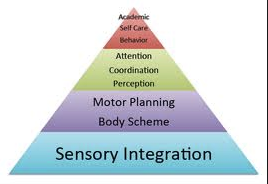TIP of the WEEK: Sensory Integration
February 16, 2013
Earlier this week I attended a training on sensory integration. I have attended many trainings on this topic in the past but each time, I come away with something new, and this time was no different. As I listened to the trainer talk about different kids with different needs, why some kids struggle with crowds, noises or tight clothing it struck me that we all struggle with sensory processing difficulties on all different levels. I do not like certain materials of clothing or textures of food and my mood would directly reflect that preference if I was made to wear or eat something that I did not like the feel of. We put kids in classrooms with loud noises or too bright lights and look to the child to correct their behavior when it is unwanted or otherwise negative.
The truth is that some kids feel itchy in any type of clothing and their fidgeting is not always a result of ADHD, non-compliance or attention seeking as we often label them. They have a sensory processing difficulty and we should look to reduce their discomfort instead of medicating or using behavioral interventions to reduce what we see as disruptive behavior. Of course in some cases kids do require medications or other interventions to reduce unwanted behaviors, but we need to look to the basics first:
-
Are they comfortable?
-
Can they see?
-
Can they hear over the background noises?
-
Are they too cold or too hot?
-
Do they feel physically grounded to the floor or are they dizzy or off balance?
Our kids are so good at compensating for what they struggle with and it is how they can often go so long with real issues before anyone picks up on it. A registered occupational therapist can tell you if your child has needs in this area. All too often our kids are denied ongoing OT because, again, they can often appear as though they would not benefit from this. Push for it. Demand it. Our kids do not always develop their senses in a typical way as a result of poor muscle tone and dysfunction of the endocrine system and it isn’t until later in life, often once they reach school age, that we see the struggles that they are having. Early work with a registered OT can save a lot of time in meetings later on with teachers and administrators telling you that your child can’t seem to sit still or can’t focus, won’t follow directions or is disrupting the group.
Before you let anyone tell you that your child needs medication or a special plan in place, especially if that plan involves restrictions, ask yourself- is he comfortable? Is she grounded in space (not dizzy or feeling like she’s tipping)? Does he feel constricted or not constricted enough? Does she always seem to bump into things, is she “clumsy” or tripping more than she should? Does he cover his ears even at the slightest noise? Is she only happy when she’s moving or is she fearful of any movements other than walking? These are all signs of sensory processing disorder and the great news is that there is a lot that you can do about it.
Your child does not have to live their lives being uncomfortable or feeling out of control. Sensory integration as a part of daily life will make an enormous improvement to your child’s quality of life. Always consult a registered OT before incorporating sensory integration but do it soon and do it often because I have seen firsthand the transformation that takes place once we target and treat the problematic areas.
We’d love to hear your stories of how sensory integration has improved your child’s life!
Patrice Carroll is Latham Centers’ world-renowned Prader-Willi Syndrome specialist. She works with Latham Centers’ residents with PWS, their families and consultants, continuously learning and teaching about PWS best practices.


